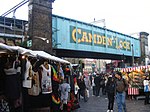Chalk Farm Road

Chalk Farm Road is a street in the Camden Town area of London. There is a widespread misapprehension that the road that runs through Camden Market is part of Camden High Street, but it is actually Chalk Farm Road. Camden Market is a major centre for the retailing of street fashions and other goods targeted at teenagers and young adults, and Chalk Farm Road has an alternative culture atmosphere. The street is part of the route from central London to Hampstead. It is a continuation of Camden High Street, and begins at the Bridge over Regent's Canal. Chalk Farm underground station, on the Northern line, is at the northern end. Entertainment venues in Chalk Farm Road include The Roundhouse, which occupies a former railway shed. Pink Floyd played the first ever show there in 1966 and it was the venue for the only UK gig by The Doors.
Excerpt from the Wikipedia article Chalk Farm Road (License: CC BY-SA 3.0, Authors, Images).Chalk Farm Road
Chalk Farm Road, London Chalk Farm (London Borough of Camden)
Geographical coordinates (GPS) Address Nearby Places Show on map
Geographical coordinates (GPS)
| Latitude | Longitude |
|---|---|
| N 51.54291 ° | E -0.14897 ° |
Address
Near & Far
Chalk Farm Road 48
NW1 8BG London, Chalk Farm (London Borough of Camden)
England, United Kingdom
Open on Google Maps











